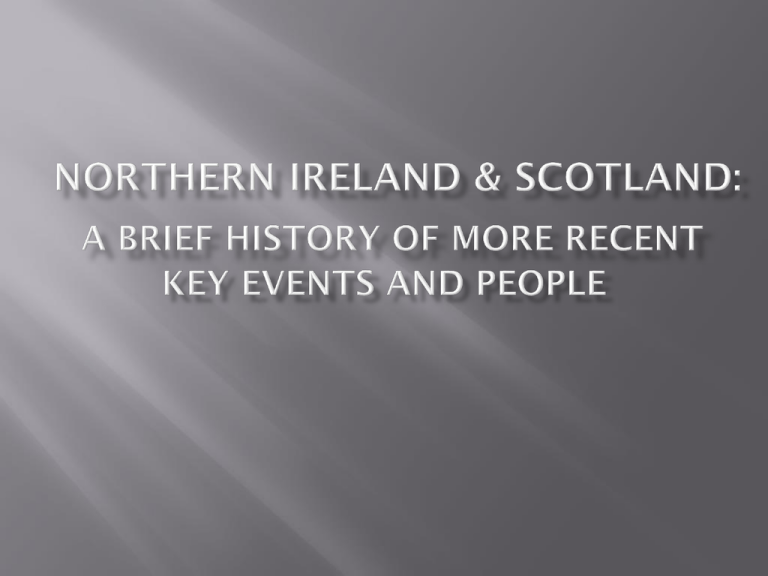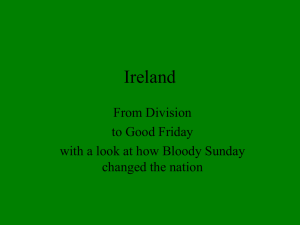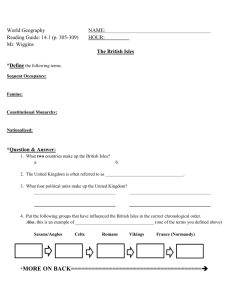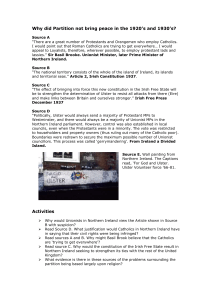Document 10400641
advertisement

Internationally, NI is probably best known as the site of a violent ethnic, sectarian, nationalist, and political conflict – the Troubles – between the nationalists, who see themselves as primarily Irish and are predominately Roman Catholic, and the unionists, who consider themselves primarily British and are predominately Protestant (additionally, there are people from both sides who identify with more extreme positions) Simply put, the unionists want NI to remain as part of the UK (“loyalist” is a term used to identify as an extreme unionist), while the nationalists want NI to reunify with the Republic of Ireland, independent of British rule (“republican” is a term used to identify as an extreme nationalist) Since 1998, all of the paramilitary groups involved in the Troubles (e.g. IRA and UVF) have ceased their armed campaigns. A Brief History of the Troubles: Early 1600s •The Plantation of Ulster refers to the colonization of Ulster – a province in northern Ireland– by Protestants from Scotland and England. •Private plantation by wealthy landowners began in 1606, while officially sanctioned by James I in 1609. •All lands owned by Irish chieftains in Ulster (along with those of their supporters) were confiscated and used to settle the colonists. The counties of Ulster (modern boundaries) that were colonized during the plantation era - shaded area 1688 – William of Orange British Protestants “invite” William of Orange, a Protestant prince from the Netherlands, to rule England and Scotland. When he arrives in Britain James II the ruling Catholic king - is deposed and flees to Ireland. In 1690 William defeats James at the Battle of the Boyne. after battle the Irish Protestants who fought alongside William are known as Orangemen. The battle is commemorated every July 12 with Orange marches in many cities in Northern Ireland. Battle of the Boyne (12 July 1690) 1690 – a system of Protestant English rule is imposed which is designed to materially disadvantage the Catholic majority and Protestant dissenters 1801 – Act of Union This system was extended again during the 18th C. and parts of it continued up to 1998. the entire island of Ireland becomes part of UK 1905 – Sinn Féin political party is established by Catholics with the intention of freeing Ireland from British rule 1913 – Ulster Volunteer Force (UVF) a paramilitary group created by Protestants who oppose the concept of Irish Home Rule. 1916 – The Easter Uprising Political and sectarian conflict over whether Ireland should remain part of the UK culminates in the Easter Uprising, when Irish Catholics seize strategic buildings in Dublin, notably the general post office. An est. 20,000 British soldiers enter the city and fire on the rebels. The fighting lasts for five days and the rebels are forced to surrender. Seventy are sentenced to death and 15 are executed, fuelling support for Sinn Féin – the political party representing the nationalist cause. Catholic rebels become known as the Irish Republican Army (IRA). 1919-1922 – War of Independence & the Partitioning of the Ireland Following the Easter Up-Rising, Sinn Féin won a majority of seats in Ireland and set up the First Irish Parliament in Dublin. Ireland declares its secession from the UK. The Irish War for Independence followed, leading to the establishment of the Irish Free State. In Ulster, however, and particularly in the six counties which became as Northern Ireland, Sinn Féin fared poorly in the 1918 election, and Unionists won a strong majority. The Government of Ireland Act 1920 partitioned the island of Ireland into two separate jurisdictions, Southern Ireland (comprising the 26 southern counties – each with a Catholic majority) and Northern Ireland (comprising the 6 Ulster counties – each with a Protestant majority), both as devolved regions of the United Kingdom. This partition of Ireland was confirmed when the Parliament of Northern Ireland exercised its right in December 1922 under the Anglo-Irish Treaty of 1921 to opt out of the newly established Irish Free State. Violence escalates as Catholics oppose partition. The Anglo-Irish Treaty, 1921 provided for a selfgoverning Irish state in the south, having its own army and police. However, rather than creating the independent republic, which was favored by nationalists, the Irish Free State would be an “autonomous dominion of the British Empire” with the British monarch as head of state, in the same manner as Canada and Australia. Michael Collins was an Irish revolutionary leader, Director of the Irish delegation during the Anglo-Irish Treaty negotiations. Subsequently, he was Chairman of the Provisional Government until his death during the Irish Civil War. His “compromise” on Northern Ireland not being immediately included in the Anglo-Irish Treaty is still viewed by many in Northern Ireland as selling them out. 1922-26 - The Irish Civil War waged between two opposing groups of Irish nationalists: the forces of the "Provisional Government" that established the Free State in December 1922, who supported the Anglo-Irish Treaty, and the Republican opposition, for whom the Treaty represented a betrayal of the Irish Republic. The war was won by the Free State forces. National Army soldiers during the Civil War 1948 - Irish Free State is granted full independence from Britain and formally becomes the Republic of Ireland. 1967 –many the 19th C. anti-Catholic laws still remain on the books as a result of the Northern Ireland parliament being dominated by Protestant unionists. 1968 – Duke Street March – a republican demonstration is attacked by the police, known as the Royal Ulster Constabulary (RUC). RUC is comprised entirely of Protestants. Many date the beginning of the Troubles with this event. 1971-72: Internment and Bloody Sunday Nearly 2,000 people are interned and held without trial, in a bid to prevent further attacks on British troops. After internment is introduced, in August 1971, violent protests follow that leave 17 dead. The move increases support for the IRA. On Jan 30, 1972 British soldiers kill 14 and injure 14 others during a civil rights march in the Bogside area of Derry/Londonderry against internment in what will become known as Bloody Sunday. Thousands of people join the IRA. Amid increasing violence, the Stormont Parliament (the Government of Northern Ireland) in Belfast is suspended and Northern Ireland is ruled directly from London. Mural by Bogside Artists depicting all who were killed by British soldiers The 1980s: Hunger Strikes Bobby Sands (IRA leader held at the Maze prison) dies after refusing food for 66 days. Nine others die of starvation between May 12 and August 20 1981. Many believe them to be martyrs to the struggle for independence. An est. 10,000 people attend Bobby Sands' funeral. Support for Sinn Fein increases rapidly. July 1997 - Ceasefire Restored The IRA announces another ceasefire, allowing Sinn Féin to join multi-party talks. Talks are hindered by paramilitary killings on both sides, but they continue until April 1998. April 1998 - The Good Friday Agreement An agreement on NI governance is finally reached. It includes a devolved parliament and a role for the Republic of Ireland in Northern Ireland affairs. Many Unionists oppose the deal as giving too much power to Catholics. A 'Yes' campaign poster for the Good Friday Agreement GREEN = YES RED = NO Scottish Devolution Referendum (1998) YES= 52% NO= 48% YES NO Professor Johnston 1,617,989 2,001,926 45% 55%








